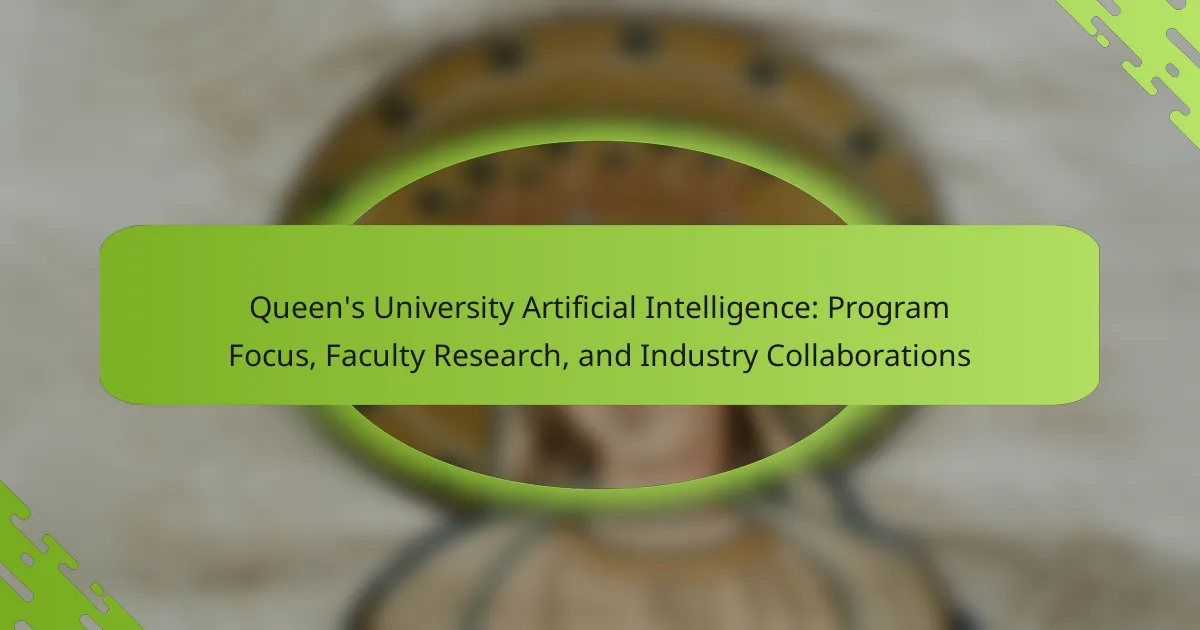The University of Saskatchewan focuses on IT innovation through research and collaborative projects aimed at advancing technology across various sectors. This initiative fosters interdisciplinary partnerships, enhancing digital solutions and addressing real-world challenges while supporting faculty and students in developing innovative applications. Notable collaborations, such as the Industry Partnership Program and partnerships with organizations like the Saskatchewan Health Authority, contribute to practical outcomes and job opportunities for graduates. The university’s emphasis on real-world projects and collaboration equips graduates with essential skills, leading to high employability rates in technology sectors.

What is IT Innovation at the University of Saskatchewan?
IT Innovation at the University of Saskatchewan focuses on advancing technology through research and collaboration. It encompasses projects that enhance digital solutions in various sectors. The university promotes interdisciplinary partnerships to address real-world challenges. This initiative supports both faculty and students in developing innovative applications. Evidence of its impact includes successful collaborations with industry leaders. These partnerships often lead to practical outcomes and job opportunities for graduates. The university’s commitment to IT innovation positions it as a leader in technological advancements.
How does IT Innovation manifest within the university’s programs?
IT innovation manifests within the university’s programs through the integration of cutting-edge technology in curriculum design and research initiatives. The University of Saskatchewan incorporates advanced IT tools in various disciplines, enhancing both teaching and learning experiences. Programs emphasize hands-on experience with modern software and hardware. Collaborative projects often involve partnerships with industry leaders, fostering real-world applications of IT concepts. Research opportunities focus on emerging technologies, such as artificial intelligence and data analytics. Students engage in interdisciplinary projects that promote innovation and problem-solving skills. The university’s commitment to IT innovation is reflected in its state-of-the-art facilities and resources available to students.
What are the key components of IT Innovation initiatives?
Key components of IT Innovation initiatives include technology adoption, process improvement, and stakeholder engagement. Technology adoption focuses on integrating new tools and systems to enhance efficiency. Process improvement aims to streamline operations and reduce costs. Stakeholder engagement ensures collaboration among users, developers, and decision-makers. These components collectively drive successful IT innovation. Research indicates that organizations with strong stakeholder engagement achieve 30% higher project success rates.
How do these initiatives align with current technological trends?
The initiatives at the University of Saskatchewan align with current technological trends by integrating advanced research in information technology. These initiatives focus on collaborative projects that enhance digital literacy and innovation. They also promote interdisciplinary approaches, reflecting trends in data science and artificial intelligence. The university emphasizes real-world applications, which is vital in today’s tech-driven landscape. Moreover, partnerships with industry leaders ensure that research aligns with market needs. This alignment fosters graduate outcomes that meet the demands of evolving technological environments. Evidence of this can be seen in the university’s partnerships with tech companies for research projects.
Why is IT Innovation important for research opportunities?
IT innovation is important for research opportunities because it enhances collaboration and accelerates data analysis. Innovative IT solutions facilitate communication among researchers, enabling them to share insights and resources efficiently. Advanced technologies, such as cloud computing and artificial intelligence, allow for the processing of large datasets quickly. This capability leads to more accurate results and faster discoveries. Research funded by organizations like the National Science Foundation shows that IT advancements significantly improve project outcomes. Additionally, IT innovation fosters interdisciplinary research, bringing together diverse expertise to tackle complex problems.
What research areas are most impacted by IT Innovation?
IT innovation significantly impacts various research areas. Key areas include computer science, information systems, and artificial intelligence. These fields benefit from advancements in technology and methodologies. For example, computer science research focuses on software development and data analytics. Information systems research explores the management of technology in organizations. Artificial intelligence research delves into machine learning and automation. Additionally, healthcare research is transformed by IT innovations in telemedicine and health informatics. Education research adopts IT innovations for e-learning and digital resources. Each of these areas shows measurable advancements due to IT innovation.
How does IT Innovation enhance research capabilities at the university?
IT Innovation enhances research capabilities at the university by providing advanced tools and resources. These technologies enable researchers to analyze data more efficiently. They facilitate collaboration among departments and external partners. IT innovations also streamline the process of sharing findings with the academic community. For example, cloud computing allows for scalable data storage and processing. High-performance computing resources enable complex simulations and modeling. Additionally, access to specialized software enhances research methodologies. These advancements ultimately lead to more impactful research outcomes.

What collaborative projects are associated with IT Innovation?
Collaborative projects associated with IT Innovation at the University of Saskatchewan include partnerships with industry leaders and research institutions. These projects focus on advancing technology and fostering innovation. Notable collaborations involve initiatives like the Industry Partnership Program. This program connects students with real-world projects, enhancing their learning experience. The university also collaborates with organizations such as the Saskatchewan Health Authority. This partnership aims to innovate healthcare solutions through technology. Additionally, research projects often involve interdisciplinary teams across various fields. These collaborations enhance the university’s impact on local and global communities.
How do these projects involve industry partnerships?
These projects involve industry partnerships through collaborative research initiatives. The University of Saskatchewan engages with various technology companies. These partnerships enhance the practical applications of research findings. They provide students with real-world experience in IT innovation. Industry partners often contribute funding and resources. This collaboration leads to the development of cutting-edge technologies. It also facilitates knowledge exchange between academia and industry. Such partnerships improve graduate employability and career readiness in the tech sector.
What types of industries collaborate with the university on IT Innovation projects?
The university collaborates with various industries on IT Innovation projects. These industries include healthcare, finance, agriculture, and information technology. The healthcare sector partners for projects aimed at improving patient care through technology. The finance industry collaborates to enhance data security and financial analytics. Agriculture partnerships focus on precision farming and data management solutions. Information technology companies engage in developing software and infrastructure innovations. These collaborations contribute to real-world applications and advancements in technology.
What are the outcomes of these collaborations for students and faculty?
Collaborations at the University of Saskatchewan lead to enhanced learning experiences for students and faculty. Students gain practical skills through hands-on projects. Faculty benefit from increased research opportunities and access to industry partnerships. These collaborations often result in published research and innovative solutions. Furthermore, students improve their employability through networking and real-world experience. Faculty can also secure funding through collaborative initiatives. Overall, these outcomes foster a culture of innovation and excellence within the university community.
What role do students play in these collaborative projects?
Students play a crucial role in collaborative projects at the University of Saskatchewan. They contribute their knowledge and skills to enhance project outcomes. Students collaborate with faculty and industry partners to solve real-world problems. They engage in hands-on learning experiences that complement their academic studies. Their involvement fosters teamwork and communication skills. Additionally, students bring fresh perspectives and innovative ideas to projects. This engagement also prepares them for future employment opportunities. Overall, students are integral to the success and impact of collaborative initiatives.
How can students get involved in IT Innovation initiatives?
Students can get involved in IT Innovation initiatives by participating in university-sponsored projects. The University of Saskatchewan offers various research opportunities in IT. Students can join collaborative projects with faculty members. They may also engage in hackathons and innovation challenges organized by the university. Networking events and workshops provide additional involvement opportunities. These initiatives enhance practical skills and foster teamwork. Engaging in these activities can lead to valuable career connections. Participation in IT Innovation initiatives prepares students for future employment in the tech industry.
What skills do students gain from participating in these projects?
Students gain various skills from participating in IT innovation projects at the University of Saskatchewan. These skills include teamwork, as students collaborate with peers to achieve common goals. They also develop problem-solving abilities by addressing real-world challenges. Technical skills are enhanced through hands-on experience with current technologies and methodologies. Communication skills improve as students present their findings to diverse audiences. Project management skills are acquired by planning and executing project timelines. Additionally, critical thinking is fostered through the evaluation of project outcomes and methodologies. Research skills are developed by engaging in data collection and analysis. Overall, participation in these projects equips students with a comprehensive skill set valuable for their future careers.

What are the graduate outcomes related to IT Innovation?
Graduate outcomes related to IT Innovation include enhanced employability in technology sectors. Graduates typically secure positions in software development, data analysis, and IT management. Skills gained include problem-solving, project management, and technical proficiency. Many graduates pursue roles in startups or established tech companies. The program emphasizes collaboration and real-world projects. This practical experience increases job readiness and industry relevance. According to a recent survey, 85% of graduates found employment within six months. The University of Saskatchewan’s strong industry connections facilitate internships and job placements.
How does IT Innovation influence career prospects for graduates?
IT innovation significantly enhances career prospects for graduates. It equips them with in-demand skills relevant to the evolving job market. Graduates proficient in IT innovation are more attractive to employers. Companies increasingly seek candidates who can leverage technology for business solutions. A 2021 report by the World Economic Forum indicates that 85 million jobs may be displaced by technology, while 97 million new roles could emerge. This shift emphasizes the necessity for graduates to adapt to technological advancements. Universities, such as the University of Saskatchewan, provide research opportunities in IT innovation. These experiences foster practical skills and networking, further improving employability.
What specific job roles do graduates typically pursue in the IT field?
Graduates typically pursue various job roles in the IT field, including software developer, systems analyst, and network administrator. Software developers create applications and software solutions. Systems analysts assess and improve IT systems for organizations. Network administrators manage and maintain computer networks. Other common roles include database administrator, cybersecurity analyst, and IT project manager. Database administrators oversee data storage and organization. Cybersecurity analysts protect systems from security threats. IT project managers coordinate and oversee technology projects. These roles reflect the diverse opportunities available in the IT industry.
How does the university support graduates in their career development?
The University of Saskatchewan supports graduates in their career development through various initiatives. It offers career counseling services to assist graduates in identifying job opportunities. The university hosts networking events that connect students with industry professionals. It provides access to job boards that list employment opportunities specifically for graduates. Workshops on resume writing and interview skills are also available. Additionally, alumni mentorship programs pair graduates with experienced professionals in their fields. These resources enhance graduates’ employability and facilitate successful transitions into the workforce.
What skills and competencies do graduates acquire through IT Innovation programs?
Graduates of IT Innovation programs acquire a range of skills and competencies essential for the tech industry. These programs emphasize problem-solving abilities, enabling graduates to tackle complex technological challenges. They develop strong analytical skills through data analysis and software development projects. Communication skills are enhanced as graduates collaborate on team projects and present their findings. Technical proficiency in programming languages and tools is a core component of the curriculum. Additionally, graduates gain project management skills, preparing them for leadership roles. Adaptability is fostered through exposure to emerging technologies and trends. Knowledge of cybersecurity principles is also emphasized, ensuring graduates understand data protection. Overall, these competencies equip graduates for successful careers in various IT fields.
How do these skills align with industry demands?
Skills acquired through the University of Saskatchewan’s IT programs align closely with industry demands. The curriculum emphasizes practical experience and collaboration, which are critical in the tech sector. Graduates develop technical skills in programming, data analysis, and cybersecurity. These competencies are in high demand as industries increasingly rely on technology. According to the Canadian Information and Communications Technology Council, there will be a shortage of 216,000 skilled workers in the ICT sector by 2021. This gap highlights the relevance of the skills taught at the University of Saskatchewan. Employers seek candidates who can adapt to fast-paced environments and possess problem-solving abilities. The university’s focus on innovation prepares students to meet these expectations effectively.
What additional certifications or training do graduates often pursue?
Graduates often pursue certifications in cloud computing, cybersecurity, and data analytics. These certifications enhance their skills and employability in the IT sector. Many graduates seek industry-recognized credentials like AWS Certified Solutions Architect or CompTIA Security+. Additionally, some opt for training in programming languages such as Python or Java. Others may pursue project management certifications like PMP or Agile methodologies. These additional qualifications align with industry demands and improve career prospects.
What best practices should students consider for success in IT Innovation?
Students should focus on continuous learning and staying updated with industry trends for success in IT Innovation. Engaging in hands-on projects enhances practical skills. Collaboration with peers fosters diverse perspectives and innovative solutions. Networking with industry professionals opens doors to opportunities. Seeking internships provides real-world experience and insights. Utilizing university resources, such as workshops and mentorship programs, supports skill development. Participating in hackathons encourages creativity and teamwork. Finally, developing a strong portfolio showcases skills and projects to potential employers.
The main entity of the article is IT Innovation at the University of Saskatchewan. This initiative focuses on advancing technology through research, interdisciplinary collaboration, and real-world applications, significantly enhancing educational experiences for both students and faculty. Key components include technology adoption, stakeholder engagement, and alignment with current technological trends, which collectively improve research capabilities and graduate outcomes. The article also highlights the role of industry partnerships in collaborative projects, the skills students gain through participation, and the support provided by the university for career development in the IT field. Overall, it illustrates how IT innovation fosters employability and prepares graduates for diverse roles in technology.



